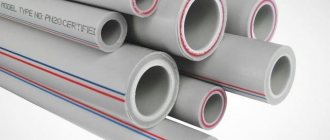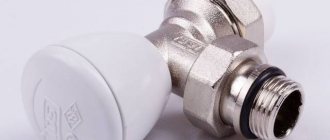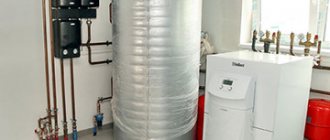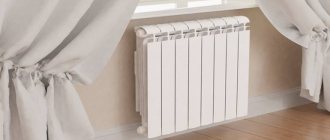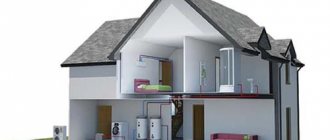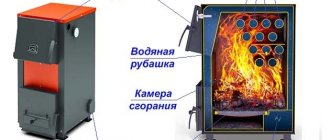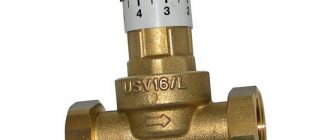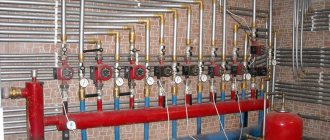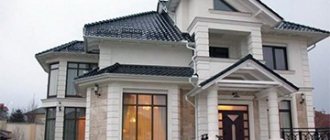Greetings, comrades! Today I am going to introduce you to several popular options for a combined heating system for a private home. I will tell you exactly which components can be combined, what benefits this provides, and, as one example, I will describe the heating scheme for my house. Let's get started.
Boiler room with two heat sources - solid fuel and electric.
What we combine
Within the same house the following can function alternately or simultaneously:
- Different heat sources (usually boilers using different types of energy carriers) connected to a common heating circuit;
- Two or more completely independent heating systems . They can divide the house into several rooms heated in different ways or, if necessary, replace each other throughout its entire area;
- One heating circuit with two or more types of heating devices.
Now let's move on to studying samples of such heating systems.
Option 1: convection and underfloor heating
Device
In one heating circuit, radiators and heated floors operate simultaneously or alternately. This scheme of work can be implemented in two ways:
| Scheme | Description |
| The warm floor is powered from the radiator return . In this case, the return temperature at the outlet of the high-temperature circuit should not be higher than 40 degrees, and the boiler should be able to operate at a return temperature of about 30 °C. Of modern boilers, only gas condensing boilers are capable of this. The obvious disadvantage of such a scheme is the impossibility of independent operation of the circuits: if you turn off the radiators, the coolant temperature will be too high for a heated floor, and without an in-floor circuit, the return temperature at its inlet will rise to values unacceptable for the boiler. | |
| The heated floor is connected independently of the radiators through a three-way mixer. Depending on the temperature at the outlet of the in-floor circuit, the mixing valve opens or closes, increasing or decreasing the amount of hot coolant from the supply in the recirculation circuit. Recirculation of the coolant in the low-temperature circuit is ensured by its own circulation pump. The circuit works with any boiler; the radiator and heated floor circuits can be turned on and off independently of each other. |
What materials should you prefer when installing such a system yourself?
Pipes:
- For radiator heating - inexpensive polypropylene with aluminum reinforcement. The temperature in the autonomous circuit does not rise above 80 °C, and the pressure does not exceed 2.5 kgf/cm2, which is exceeded with a margin by the operational parameters acceptable for polypropylene pipes. Reinforcement reduces the elongation of pipelines when heated: for unreinforced polypropylene it is 6.5 mm/linear meter when heated by 50 degrees, for reinforced with aluminum foil - 1.5 mm;
When heated, rigidly fixed unreinforced polypropylene pipes will wave due to elongation.
- For the heated floor contour - cross-linked or thermally modified polyethylene. Pipes are supplied in coils up to 200 meters long; this allows you to move all connections outside the screed.
Laying water heated floor pipes in a screed. For underfloor heating, a pipe made of thermally modified polyethylene PE-RT is used.
Radiators : aluminum sectional. The instruction is due to the fact that they combine high heat output (up to 210 watts per section) with low cost (from 240 rubles/section).
An aluminum radiator will provide an optimal balance of price and heat transfer.
Advantages
The disadvantage of radiator heating is the irrational distribution of temperatures in the heated volume. The air near the ceiling is several degrees warmer than above the floor. But the space under the ceiling is uninhabited, and heating it only increases heat loss through the ceiling and the top of the walls.
Warm floors are more economical: they heat the room from below; As you approach the ceiling, the temperature drops. A decrease in the average temperature in the heated volume leads to a decrease in total heat loss.
Air temperature in a heated room with convection and underfloor heating.
The disadvantage of a heated floor is that its temperature is limited to +35-+40°C. With a fixed heat exchange area and limited temperature, heat transfer is also limited, and with large heat losses it may be insufficient.
Radiators will help make up for the heat deficit. In an autonomous circuit, they can heat up to 75-80 degrees and, due to the greater temperature difference with the air, give off much more heat than a warm floor with the same surface area.
Types of combined heating systems
A combined heating circulation system can be represented by one of the following options:
- radiators and water heated floors;
- radiators and warm walls;
- warm floor and walls;
- heating radiators, warm water floors and warm walls.
All devices used are located in the same room and connected to one collector. An important feature of such a system is the ability to efficiently use energy sources, increase efficiency and reduce heat loss.
Radiators and heated floors
Such a heating system can be installed both in a private house and in an apartment. The reason for installing it in an apartment may be:
- low quality radiator heating;
- The walls are poorly insulated.
Many people solve this issue by the method of least resistance - they use oil heaters and convectors. However, these devices dry out the air, cause discomfort, and can even cause illness in the household.
In apartments, the “warm floor” heating system can be installed on a screed under the floor covering, and therefore does not take up much space.
Suitable for the following premises:
- kitchen;
- balcony;
- bathroom
In combination with central heating radiators, electric (infrared) and water heated floors are most often used.
Water heated floors
A water heated floor cannot be the only way to heat an apartment, since hot water is supplied to it from the main heating system. For its installation in residential apartment buildings, a special permit is required.
For private households, a water floor system can become not only an auxiliary, but also the only means of heating. In this case, the water for the system is heated using a gas water heater or boiler.
There are two ways to lay pipes for radiators and underfloor heating:
- spiral – for large rooms;
- zigzag - suitable for rooms with a small area.
The heated water is supplied to the collector - the place from where it is distributed throughout the heating circuits.
Such floors should be provided during the construction or major renovation stage. This is due to the need to remove the flooring and cut a niche in the wall for the collector.
Electric heated floors
Installing electric underfloor heating in combination with radiators is the most popular way to heat a home. This is due to the fact that when installed, these floors do not need to be connected to the water supply and install manifolds.
Electric floors are:
- infrared;
- matte;
- cable
The surface of the cable floor is heated through a cable laid in a snake under the finishing coating. The thermostat reacts to temperature changes and starts the cable.
A matte floor is different in that the cable on it is initially laid at a certain pitch and cannot be changed.
Now a new type of heated floors has appeared - infrared; they have a thin but durable film into which special carbon plates are mounted. This coating option is the most economical, and heat transfer occurs due to infrared radiation.
Option 2: gas and diesel
Device
A universal boiler is installed in a single heating circuit, designed to use both types of fuel. Switching from solar to gas and back requires only replacing the burner.
The VAILLANT VKO 408 universal boiler is capable of switching from diesel fuel to main gas after simply replacing the burner.
Advantages
Coordination of connecting a built house to the gas main and installation of the input take from several months to 2-3 years. If you have already moved into a built house, in winter you need something to heat.
A universal boiler will be an excellent compromise, requiring minimal investment:
- Before connecting gas, you heat with diesel fuel;
- As soon as the house is connected to the gas mains, you switch to gas without any additional investments.
The wait for gasification at home may be lengthy. A universal boiler will allow you to provide heating from the moment you move in and then quickly switch to a new type of fuel.
Reference: the price of a kilowatt-hour of heat when burning diesel fuel and main gas differs by 5-7 times (0.5-0.7 rubles versus 3.5-4).
Option 3: solid fuel and electric boilers
Device
Both boilers are connected in parallel to a common heating circuit and operate alternately for heating. An additional element of the piping, common to both heat sources, can be a heat accumulator - a volumetric tank with thermal insulation that can keep the water temperature constant for a long time.
Heating system for a private house with solid fuel and electric boilers. The heating and hot water supply systems are powered from the buffer tank (heat accumulator).
Advantages
- Energy independence . During long power outages, you can always switch to solid fuel (wood, pellets or coal);
If solid fuel is used as the main heat source, the electric boiler acts as an insurance provider. It will provide your home with heat if you run out of firewood or coal, and their delivery is delayed for some reason.
- Ease of use . At night, the owner of such a heating system does not have to wake up to light the fire: it is enough to allow the electric boiler to maintain the set coolant temperature;
- Economical when running on electricity. With a two-rate tariff, you can use electricity at a cheaper nightly rate. During the day, when a kilowatt-hour costs three times as much, the heating system runs on solid fuel.
The two-tariff meter separately takes into account daytime and nighttime energy consumption. They are charged at different rates.
What functions does the heat accumulator perform in this circuit?
- Increases the operating time of the heating system of a private home using cheap electricity. The electric boiler heats the water in the tank during the night tariff. In the morning, the accumulated heat is used to heat the house;
- Makes lighting of a solid fuel boiler less frequent during the day. The boiler, operating at full power, heats up the water in the buffer tank in a short time and remains idle for the next few hours.
The use of a heat accumulator is more beneficial than a covered boiler vent, which limits its thermal power. A classic boiler with limited air flow reduces efficiency (efficiency factor) due to incomplete combustion of fuel. When operating at full power, the boiler efficiency is maximum.
The thermostat of a solid fuel boiler reduces its power by covering the vent. With limited air flow, the fuel does not burn completely, and your money literally goes down the drain.
Types of combined heating systems
A combined heating system for a private home can include various coolants, thanks to which the devices can be divided into the following types:
- gas plus diesel boiler equipment. This design can be made of cast iron or steel, or combines both materials. Owners of private houses with a gas pipeline nearby use combined boilers - diesel fuel plus gas. This boiler model is very economical;
- gas plus solid fuel equipment. This system combines gas mixed with solid fuel. Such equipment can be multi-fuel, since it is possible to use firewood and coal. This combined equipment is not entirely effective. The device does not have automatic switching. Even because the design is quite complex, such a device is in demand due to its low and favorable price;
- solid fuel plus electrical equipment. Combined heating of a private house with wood and electricity to heat the room, this combination can very often be seen in country houses. The power connection is to electricity - 220 or 380 Volts, with a power of 5-8 kW. While the owners are in the mansion, general heating is carried out with wood or coal; after leaving and burning the fuel, the temperature in the boiler drops and a relay is activated, turning on the electrical equipment. Thus, during the absence of the owners, the system itself maintains the desired temperature in the room. This device is not cheap, but the result is worth it. But you can be absolutely confident in the reliability of the device;
- gas plus solid fuel and electrical equipment. Perhaps, this type of combined heating boilers for a private home can rightfully be called the best. Because it already runs on three types of fuel, this means that the efficiency of the heating system increases. This design can be installed in any area, but must be equipped with a gas pipeline. If for any reason there are interruptions in gas and electricity, owners will always be able to use any type of solid fuel;
- pyrolysis plus electrodes. This device is suitable for heating a country house. By combining a pyrolysis and electrode boiler, it becomes possible to maintain the desired room temperature, even in the absence of the owners. The system consists of two multi-fuel devices and is very popular.
Solid fuel and electric heating
Option 4: air source heat pump + wood
Device
This scheme was implemented in the neighboring house. A heat pump operating according to the “air-water” scheme is used as the main heat source: the external unit takes heat from the surrounding air, the internal unit transfers the resulting heat to the coolant (water in the heated floor circuit). An additional source of energy is a wood-burning fireplace with a water jacket around the firebox.
Diagram of connecting a fireplace to a water heating system at home.
Advantages
A heat pump is more profitable than any direct heating device (including an electric boiler): it provides an effective efficiency of ... 200-500%.
Excuse me, but how is this possible? After all, the efficiency, by definition, cannot be more than 100%, right?
The fact is that the device is not a source of heat. It only pumps it into the house, taking it from a low-potential (read - heated to a lower temperature compared to the heated room) source - the external environment. Electricity is spent only on the operation of the compressor, which circulates the refrigerant.
When a heat pump operates, the source of most of the energy is the external environment.
Heat pumps have two common features:
- Relationship between efficiency and temperature at heat exchangers . The appliance's COP (a parameter describing the ratio of effective thermal power to electrical power) falls as the temperature difference between the evaporator and condenser increases;
Dependence of the COP of a heat pump on the temperature of the heat source medium at a constant temperature inside the house.
- Evaporator (external heat exchanger) temperature limitation . The pump cannot take air from a medium with a temperature below -25 °C. The limitation is associated with the temperature at which the state of aggregation of the refrigerant changes.
For an air source heat pump this means that:
- As the weather gets colder, the cost of heating your home will rise, both due to increased heat loss and lower COP;
- At -25 °C outside you will have to use another heat source.
This is where an additional heat exchanger in a fireplace, stove or solid fuel boiler comes to the rescue. Connected to a common circuit with the heat pump, it helps it heat the coolant, and in severe cold weather it completely takes over the heating of the house.
During severe frosts, the house switches entirely to solid fuel heating.
Other types of combined heating systems
There are a huge number of options for creating combined systems. Which combination to choose depends on the capabilities and needs of the homeowner. Experts will help you make the right choice. For example, if there is a heating system with a boiler that runs on liquid fuel and a coolant that heats the radiators, then it is not economically profitable to run such a system in the off-season. At this time of year, it is more advisable to simply light the fireplace (if you have one). In the winter season, the main load will fall on the boiler, and the fireplace will be used only to create comfort.
In the southern regions of the country, the combination of a solar collector and a gas boiler, which are connected into one heating network, is becoming increasingly common. This is a very complex system, which is equipped with automatic elements. It consists of a gas boiler operating with an external hot coolant storage tank and equipped with a weather controller that can be controlled remotely. In addition, the system includes solar collectors, which are used to heat the coolant, a heat accumulator and a pump that fills the system with coolant. This system works very well in regions where there are a lot of sunny days. In the summer it works without turning on the gas boiler to produce hot water, and in the autumn-spring period it allows you to save the resource of boiler equipment and fuel.
https://www.youtube.com/watch?v=bUA6ABpvJ3Q
However, in the northern regions such a system is ineffective. Here it would be more advisable to include a heat pump in the heating system. This unit uses the natural heat of the earth, which is an inexhaustible source of energy. There is one drawback of such a device - the high price, which significantly increases the cost of creating a heating system. However, as foreign practice shows, these costs pay off very quickly. For example, in Sweden, heat pumps supply heat to almost half of private homes, and their share of domestic use is constantly growing.
Option 5: air conditioners and electric boiler
Device
My house has two independent heating schemes.
Main source of heat : inverter air conditioners installed in every room of the house. An air conditioner is a special case of an air source heat pump: it uses street air as a low-grade heat source; The internal heat exchanger transfers heat to the air of the heated room without the mediation of the coolant.
Children's room in my house. Area - 20 m2. The only heat source is a 12,000 BTU indoor inverter unit.
Inverter air conditioners differ from those using “start-stop” compressors by the ability to smoothly reduce performance. She, in turn, gives:
- Absence of peak starting loads with maximum starting currents, and, therefore, longer equipment life;
- Economical . COP of modern inverters reaches 4.2-5 versus 3.6 for the best models of traditional air conditioners;
- Low operating temperature when operating for heating (-15 – -25 degrees).
Backup heat source : Electric heating element with two-pipe water heating system. It is designed for extremely low temperatures: in Sevastopol, where I live, severe frosts are extremely rare, but they do happen once every few years.
The photo shows a backup heating element electric boiler in my house. It is designed to work in extreme frosts for the Crimea, at temperatures below -25°C.
Advantages
They relate primarily to heating with air conditioners. Here is a list of advantages of the solution:
- Economical . I have already mentioned how the thermal power of a heat pump relates to the consumed power. Heating costs me between 800 and 1500 kWh of electricity per month, depending on the weather;
When switching to an electric boiler, the combined heating in my house will lose its efficiency: to get a kilowatt of heat, you will need to spend a kilowatt of electricity. However, in four years of operation of air conditioners, the air temperature has never dropped below -20°C. The backup circuit is idle.
- Uniform air heating . Movable dampers of the internal block of the split system allow you to direct the warm flow to the floor. The heated floor itself will become a source of heat.
In addition, the flow will continuously mix the air in the room, eliminating its stratification by temperature;
By directing the blinds to the floor in heating mode, you will receive uniform heating of the air throughout the entire volume of the room.
- Low cost of implementation . The cost of purchasing and installing air conditioners amounted to a total of 110 thousand rubles; The backup heating system was installed by the previous owner of the house and cost about 40 thousand. For comparison: the cost of an air source heat pump and a fireplace with a heat exchanger in a neighboring house is 850 thousand rubles;
- Highest fault tolerance . If one of the air conditioners fails, the room without its own heat source will be heated by the remaining air conditioners through the open doors. Taking into account the number of split systems (there are 5 in the house), the load on each device will increase slightly;
- Temperature control accuracy . You can set it explicitly on the air conditioner remote control and adjust it with an accuracy of 1 degree;
The air temperature set on the remote control is maintained by the inverter with an accuracy of 0.5 °C. For comparison, with “start-stop” systems, the temperatures at which the compressor stops and starts differ by 3-4 degrees, so the air in the room alternately heats up and cools down.
- Minimum inertia . If you change the set temperature from +20 to +24 degrees, the air heats up by 4 degrees within 10-15 minutes.
Combined heating system diagrams
Depending on the type of heating system with which the home is equipped, various schemes of combined heating systems can be used.
Figure 2 shows a diagram in which two branches of the radiator system are equipped with shut-off valves (supply and return) at the outlet of the main riser. This move makes it possible, if necessary, to disconnect the battery and repair it. Here, a coolant temperature regulator (bypass) must be installed on the return line, which can be installed in a closed or open position, as well as in an intermediate position. This makes it possible to regulate the amount of hot water entering the heated floor.
This scheme is best suited for small one-story buildings.
Figure 3 shows a combined system based on a two-pipe connection scheme for heating radiators. Here, different pipes are used for coolant supply and return, which reduces pressure losses.
Figure 4 shows a diagram where the supply riser is shown in red, and the return riser in blue. At the top of the diagram there is a radiator, at the bottom - a warm floor.
Electrical systems use a floor heating cable to run the wiring. This is an outdated heating option; currently it is recommended to use infrared heated floors (Fig. 5).
All of the above diagrams are functional and can be used to connect heating in the house
For correct operation of the combined heating system, it is important to correctly install and connect the radiators to each other. To do this, you can use the services of a private foreman in the Rostov region.

